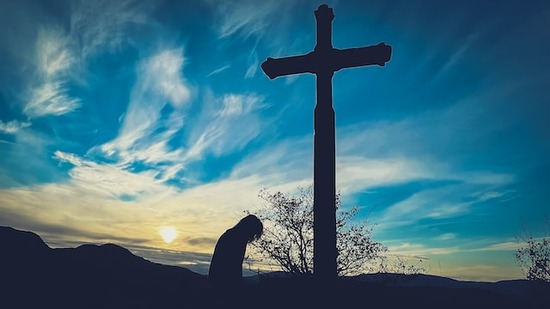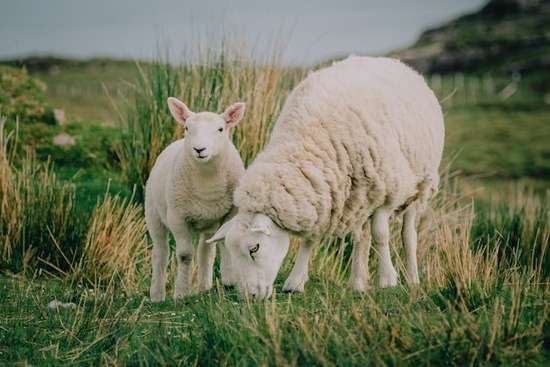What Do Adventists Believe About the Atonement?
If you’ve spent much time in the Bible books of Leviticus or Numbers, you might’ve noticed the word atonement.
Or perhaps you’ve heard a pastor use the term, too.
Seventh-day Adventists believe that Jesus Christ’s sacrifice on the Cross is the atonement for the sins of the world. In other words, His sacrifice removes the separation between us and God so we can be in close relationship with Him again.
Our Fundamental Belief about the life, death, and resurrection of Christ affirms this:
“In Christ’s life of perfect obedience to God’s will, His suffering, death, and resurrection, God provided the only means of atonement for human sin, so that those who by faith accept this atonement may have eternal life.”1
That atonement goes back to the symbols of the ancient sanctuary system in the Old Testament. Let’s go there to understand this topic better and answer some important questions:
What is “atonement” in the Bible?

Photo by Jametlene Reskp on Unsplash
Atonement in the Bible, in essence, is something that removes the effects of sin so that human beings can be reunited in their relationship with God. This concept comes up over and over again with the sacrifices of the Old Testament sanctuary systems.
The idea originates from the Hebrew word kippurim, which literally means “a covering.”2
But the word atonement has Anglo-Saxon origins and is a mashing together of the words at + one + meant to mean “a state of being ‘at one’ or in agreement.” The Greek equivalent katallagē is similar; it means “reconciliation.”3
And reconciliation is the whole point.
Biblical references to atonement have a “predominant sanctuary and sacrificial context.”4 God provided the sanctuary system to help His people understand how He would reconcile them to Himself (Exodus 25:8), even though their sins had separated them from Him.
But the Israelites knew that these rituals foreshadowed something greater. They were already aware that the earthly sanctuary pointed to a temple in heaven.5 And the sacrifices of lambs and goats were a representation of a greater sacrifice.
The sanctuary system was a symbol of how Jesus, through His sacrifice, would become the atonement for our sins.
Let’s look at how atonement was taught on a daily and yearly basis in ancient Israel. Then, we can see how it still applies to us today.
The daily atonement

Photo by Mitchell Orr on Unsplash
Each day in the ancient Israelite sanctuary, animal sacrifices and the work of the priests made atonement for the people.
Leviticus 5 details the procedure for a sacrifice when an individual sinned:
“And it shall be, when he is guilty in any of these matters, that he shall confess that he has sinned in that thing; and he shall bring his trespass offering to the LORD for his sin which he has committed, a female from the flock, a lamb or a kid of the goats as a sin offering. So the priest shall make atonement for him concerning his sin” (Leviticus 5:5-6, NKJV).
Roy Gane, Professor of Hebrew Bible and Ancient Near Eastern Languages, points out that this sacrifice removed the sin from the sinner, and that individual was “treated as though the sin had not occurred.”6
But what made that possible?
Leviticus 17:11 explains:
“For the life of the flesh is in the blood, and I have given it to you upon the altar to make atonement for your souls; for it is the blood that makes atonement for the soul” (NKJV).
It was a substitution: The animal died so that the human wouldn’t have to pay the penalty of death.7

Photo by Tingey Injury Law Firm on Unsplash
It’s the same as if you committed a crime that deserved lifetime imprisonment, but then someone offered to take your imprisonment so that you could go free.
Justice is still being satisfied—but someone else is taking your place.
Here’s how the sacrificial system illustrated that:
Since all human beings have a fallen nature, sin was of course a daily struggle. And it required regular sacrifices because of this.
So a person would bring an animal to the sanctuary for the sacrifice. There, they would put their hands on the animal, confess their sins, and then slit the throat of the animal themselves. It was a powerful lesson each time.
This ceremony was driving home the idea that the sin of that individual had a cost—life. Sin ultimately results in death.
As they saw the innocent animal bleeding, they realized just how serious their sin was—that it would ultimately cost the life of the Messiah.
Once the animal had been sacrificed, the priest continued the ceremony. They would take the blood of the animal, carry it into the Holy Place of the sanctuary, and sprinkle it before the veil that led into the Most Holy Place (Leviticus 4:6-7). Or, the priest would roast the sacrifice and eat part of it (Leviticus 10:17).
In either case, the priest was taking the place of the sinner and “carrying” the sin into the sanctuary—whether through sprinkling the blood or by bearing it in his body by eating the sacrifice.
Professor Gane explains that the atonement involved both of these parts: the sacrifice of a victim and the priestly substitution. The priest took upon himself the sins of the people, symbolizing how God bears our sins when He forgives them.8
But could the animal sacrifices really take away sin?
No. This whole system was taught to the Israelites as the earliest model of the plan of salvation, which would provide understanding not only to them, but for all those who read about it in Scripture.
So, for the time being, God assigned these ceremonies value. In the end, though, they were “massively inadequate when it came to fulfilling the needs of justice. There was a glaring need for a more valuable kind of victim and for a kind of priest who actually suffered for the culpabilities he would bear on behalf of us.”9
Jesus Christ was the perfect one to fill the role of both sacrificial victim and priest.
Before we get there, though, we need to cover one other aspect of the atonement in the sanctuary system.
The yearly atonement

Photo by Markus Spiske on Unsplash
Aside from the daily sacrifices that the priests would make in the Israelite sanctuary, a special sacrifice and set of rituals took place once a year—the tenth day of the seventh month in the Jewish calendar (Leviticus 23:27). On this day, called the Day of Atonement or cleansing of the sanctuary, the high priest would make atonement for the whole camp of Israel (Leviticus 16:30).
Here’s how Leviticus 16:32-34 describes it:
“And the priest, who is anointed and consecrated to minister as priest in his father’s place, shall make atonement, and put on the linen clothes, the holy garments; then he shall make atonement for the Holy Sanctuary, and he shall make atonement for the tabernacle of meeting and for the altar, and he shall make atonement for the priests and for all the people of the assembly. This shall be an everlasting statute for you, to make atonement for the children of Israel, for all their sins, once a year” (NKJV).
What made this day unique was that it was the only day of the year that God allowed the high priest to enter the Most Holy Place (the third and smallest compartment of the sanctuary), which represented the throne room of God.
Like visiting someone of royalty, the Israelites didn’t take this occasion lightly. Everyone in the Israelite camp would confess their sins and prepare for the high priest to go into the very presence of God as their representative.
Let’s walk through the whole ceremony as it’s described in Leviticus 16.
Before performing the ceremony, the high priest would prepare himself and offer a bull to make atonement for himself and his family (verse 6). This would make sure he was ceremonially pure before entering God’s presence.
Then, he would take two goats. One goat was “for the Lord” (verse 9), and one was known as “Azazel” or the scapegoat (verse 10).
The high priest would sacrifice the goat for the Lord and take its blood, sprinkling it in the Most Holy Place of the sanctuary over the mercy seat, the cover of the ark of the covenant, which contained the Law of God that had been broken (verse 15).
He would then work his way back out of the sanctuary, sprinkling blood in various locations along the way. The purpose was to “cleanse and consecrate it from the uncleannesses of the people of Israel” (Leviticus 16:19, ESV). In essence, the blood of the goat for the Lord symbolically purified the sanctuary of all the sins of the people that had been brought in throughout the year.
And the final part is recorded in verses 20-22:
“And when he has made an end of atoning for the Holy Place, the tabernacle of meeting, and the altar, he shall bring the live goat. Aaron shall lay both his hands on the head of the live goat, confess over it all the iniquities of the children of Israel, and all their transgressions, concerning all their sins, putting them on the head of the goat, and shall send it away into the wilderness by the hand of a suitable man. The goat shall bear on itself all their iniquities to an uninhabited land; and he shall release the goat in the wilderness” (NKJV).
The sins that had been removed from the sanctuary were placed on the scapegoat, which was sent out into the wilderness to die.
As a result, the whole Israelite camp was clean (Leviticus 16:30).
Like the daily sacrifices, though, this ceremony was ultimately inadequate for fully and completely removing sin from the sanctuary. But it looked forward to the “final and complete removal of sin from God’s universe.”10
We’ll see next how the New Testament writers help connect these rituals with today’s realities.
What does atonement have to do with salvation?

Photo by REGINE THOLEN on Unsplash
The atonement has everything to do with salvation! The Israelites performed animal sacrifices to symbolize having their sins covered and their relationship with God mended, but these were by no means capable of taking away sins (Hebrews 10:4). All simply pointed to Jesus’ work of atonement, which is fully sufficient (Hebrews 10:5-10).
Writers of the Old Testament recognized that God wasn’t bloodthirsty for animal sacrifices (Psalm 51:16; Isaiah 1:11 Hosea 6:6). The ceremonies were just a way of impressing on the people the need for a greater atonement. David prayed to God:
“As for our transgressions, You will provide atonement for them” (Psalm 65:3, NKJV).
Isaiah 53 foretold the coming of a suffering Servant who would take upon Himself the sins of the people (Isaiah 53:4-8).
And the New Testament picks up on sanctuary language, identifying Jesus as “the Lamb of God who takes away the sin of the world” (John 1:29, NKJV).
The equivalent of atonement in the New Testament is “reconciliation,” and it’s used in a couple of key verses about Jesus:
“We also rejoice in God through our Lord Jesus Christ, through whom we have now received the reconciliation” (Romans 5:11, NKJV).
“Now all things are of God, who has reconciled us to Himself through Jesus Christ” (2 Corinthians 5:18, NKJV).
So, how does Jesus provide atonement for us?
Complete atonement through Jesus Christ

Photo by Tim Wildsmith on Unsplash
The atonement that comes through Jesus involves both His sacrificial work and priestly work for us. This follows from the sanctuary teaching that the victim of sacrifice and the priest were symbols of Christ and how He bears our sins.
This point is the focus of the apostle Paul in the book of Hebrews. He showed how the Old Testament sanctuary system was inadequate, but Christ is the greater atoning sacrifice and greater priest needed for the plan of salvation.11
Here’s how Hebrews 9:11-12 puts it:
“When Christ appeared as a high priest of the good things that have come, then through the greater and more perfect tent (not made with hands, that is, not of this creation) He entered once for all into the holy places, not by means of the blood of goats and calves but by means of His own blood, thus securing an eternal redemption” (ESV).
By His death on the Cross, Jesus was the sacrificial victim, becoming the atonement for our sins. And by His ministry in the sanctuary, He applies His blood just as the priests did, making intercession for us (Hebrews 7:25).
Professor Gane is emphatic: When it comes to Jesus, “you can’t separate His priesthood from His role as the victim.”12
In other words, Jesus’ sacrifice was enough for the forgiveness of the whole world (John 3:16). And His priestly ministry in the heavenly sanctuary applies that forgiveness to each individual specifically.13
And as we saw in the Scriptures, the term atonement is also used to refer to the Day of Atonement, which cleansed all the sins of the Israelite people once a year.
How does Jesus fulfill this aspect?
Before the Second Coming, Jesus will perform a work of judgment in the heavenly sanctuary (throne room of God) that cleanses the records there of all the sins His followers have confessed (Daniel 8:14; 7:9-10). It’s sometimes called the blotting out of sin (Acts 3:19; Revelation 3:5) or the investigative judgment in Adventism.
Hebrews 9:23 talks about this event in the context of the Day of Atonement:
“Thus it was necessary for the copies of the heavenly things to be purified with these rites, but the heavenly things themselves with better sacrifices than these” (ESV).
Once this work of Christ is finished, He will return to earth and take His people to be with Him. Sin will be no more, and we will live in a perfect new earth with Him (Revelation 21).
What can atonement look like for me today?
Today, we don’t have to sacrifice animals for atonement. Christ has provided full atonement for us, which we can receive through accepting Him and His sacrifice for us.
And the beautiful thing is, accepting Jesus’ atonement is life-changing. Gane says:
“The book of Hebrews reveals the transforming effect on those who accept Christ’s…sacrifice.”14
He goes on to mention Hebrews 9:14, which explains how the blood of Christ “[purifies] our conscience from dead works to serve the living God” (ESV).
Adventist pastor Ty Gibson affirms this idea:
“The atonement not only deals with the guilt of sin. The atonement of Christ deals with the dominating power that sin has over us. And according to Romans chapter 6, the atonement of Christ has a way of liberating us from the dominion of sin.”15
Through the atonement, Jesus frees us from the power sin has had over us through the lies of Satan. We are “set free from sin,” as Romans 6:7 says, and we no longer have to live under condemnation (Romans 8:1).
We don’t have to be in bondage to the lies Satan tells us—that we can’t be forgiven, that we aren’t good enough, etc. And we don’t have to be in bondage to anger, bitterness, hatred, fear, or any other sin.
When we have accepted Jesus’ gift by faith, we can have the assurance that He, as our High Priest, will apply His blood on our behalf in the heavenly sanctuary. He will blot out our sins so that someday, we can be fully reunited with Him.
Atonement—all about relationships

Photo by Kelly Sikkema on Unsplash
The atonement, symbolized by animal sacrifices in the Old Testament and fulfilled by Christ in the New Testament, is critical to the Christian experience. It’s all about God’s plan to end sin so He can be with us again.
Ultimately, it’s “all about relationships,” in the words of Professor Gane.
God is a relational God, and He created this plan out of deep love for us and a desire for us to heal our relationship with Him.
Because He loves us so much, He’ll never force us to take those steps.
But if we’re willing to accept the gift of the atonement, He wants to transform our lives through the Holy Spirit (Hebrews 8:10).
To understand what this looks like practically,
- “What Adventists Believe About the Life, Death, and Resurrection of Christ,” Seventh-day Adventist Church. [↵]
- Horn, Siegfried, Seventh-day Adventist Bible Dictionary, Revised Ed., p. 97.[↵]
- Ibid. [↵]
- Cairus, Aecio, “Substitutionary Atonement,” Biblical Research Institute.[↵]
- Ibid. [↵]
- Gane, Roy, “Legal Substitution and Experiential Transformation in the Typology of Leviticus,” Symposium on Atonement, Adventist Theological Society. [↵]
- Ibid. [↵]
- Ibid. [↵]
- Ibid. [↵]
- Horn, p. 97-98. [↵]
- Gane, “Legal Substitution and Experiential Transformation in the Typology of Leviticus.” [↵]
- Ibid. [↵]
- Seventh-day Adventists Believe…, Review and Herald, 1988, p. 315-316. [↵]
- Gane, “Legal Substitution and Experiential Transformation in the Typology of Leviticus.” [↵]
- “Ty Gibson – Salvation/Atonement,” YouTube. [↵]
Questions about Adventists? Ask here!
Find answers to your questions about Seventh-day Adventists
More Answers
The Health Benefits of Fresh Air You Should Know About
The Health Benefits of Fresh Air You Should Know About“When you can’t breathe, nothing else matters,” the American Lung Association tells us. And while that’s true, the kind of air you’re breathing will determine the health benefits you experience. Breathing fresh...
What Do Seventh-day Adventists Choose to Eat?
What Do Seventh-day Adventists Choose to Eat?Food blogs overwhelm the internet; food fads are all the rage; and copycat and healthy versions of food are the subject of many a get-together. Eating—and eating the best way—is a big deal. And everybody has a different...
10 Incredible Ways Sunlight Can Improve Your Health
10 Incredible Ways Sunlight Can Improve Your HealthAre you concerned about sunlight’s negative effects? You might be the one who lathers on the sunscreen and covers up when you go outside. Or maybe you avoid being outside as much as possible. You might be surprised,...
Why Is Water So Important?
Why Is Water So Important?We all know that water is a substance we can’t live without. It quenches our thirst and keeps us hydrated on the inside. And it’s necessary for hygiene and cleansing on the outside too. But did you know that the cleansing properties of water...
Ellen White’s Writings and the Adventist Health Message
Seventh-day Adventists are known for their emphasis on healthy living. And Ellen G. White was a significant influence in the development of this priority and practice among Adventists.
Health Clinics
Ellen White and Adventist Healthcare—Ahead of Their Time Medical care in the mid-1800s was primitive, to say the least. Basic concepts we take for granted—such as proper handwashing or recognizing the dangers of bloodletting—were nonexistent. And doctors often had...
What Did Ellen White Teach about Vegetarianism?
What Did Ellen White Teach about Vegetarianism?One thing you might have heard about Seventh-day Adventists is their emphasis on a vegetarian lifestyle. If you’re wondering why that is, it goes back to our church’s humble beginnings: As Adventists studied the Bible,...
How Ellen White’s Teachings Can Improve Your Health
How Ellen White’s Teachings Can Improve Your Health Healthcare in the nineteenth century was said to leave “more disease than it took away” with its use of bloodletting and “medicines” like mercury and arsenic.1 As people questioned these methods, new approaches...
Change Your Perspective on Life with These 5 Mindsets
5 Biblical Mindsets to Change Your Life for the Better Sometimes, life is just plain hard. There’s no way around it. So would thinking about things differently really change anything? Our perspective on life, and everything it throws at us, affects more than we’re...
Bible Promises for When You’re Worried or Fearful
Bible Promises for When You’re Worried or Fearful The Bible is full of beautiful promises that can comfort us in a variety of situations. They can give us hope when we are hopeless, make us feel grateful for God’s love, and comfort us when we’re grieving or suffering....
12 Practical Ways to Overcome Worry
12 Practical Ways to Overcome Worry DISCLAIMER: This content is for informational purposes only. It does not constitute any professional medical advice and is not intended as a substitute for professional mental health therapy. It’s easy to get stuck in a cycle of...
How the Bible Talks About Worry, Fear, and Anxiety
How the Bible Talks About Worry, Fear, and Anxiety Worry and fear are the ingredients of anxiety. It’s easy to see how the world isn’t perfect—and the anticipation of a bad event or experience (that may or may not even happen) can end up draining the peace and...
How to Calm Anxious Thoughts, Using the Bible
How to Calm Anxious Thoughts, Using the Bible You were expecting a phone call from your daughter half an hour ago, and she still hasn’t called. She’s also not answering your calls. You feel your heart thumping as your thoughts race: What if she’s been in a car...
What You Should Know About the Adventist Health Studies
What You Should Know About the Adventist Health StudiesYou may have heard that Seventh-day Adventists care about health. But what you may not know is that Adventists have been the subjects of long-term research into lifestyle and health. Since 1958, researchers from...
Benefits of Sunlight
Yes, There Are Health Benefits of SunlightDespite the bad reputation it’s gotten, sunlight is generally associated with positivity, as shown by songs like “You Are My Sunshine,” or phrases that refer to delightful people as having a “sunny disposition.” There’s a...
Why Your Body Needs Rest for Optimal Health
Why Your Body Needs Rest for Optimal HealthStruggling to think straight? Wondering why you can’t remember that important tidbit you heard earlier today? Feeling like your emotions are about to explode? These are just some of the symptoms that can reveal your need for...
The Seventh-day Adventist Diet: One of Our Key Longevity Secrets
The Seventh-day Adventist Diet: One of Our Key Longevity SecretsOats, avocados, lentils, tofu—probably not what you first think of in a standard American diet. But if you show up at the home of an Adventist, chances are you may be served one of these staples. Out of a...
Why You Need Fresh Air
Why You Need Fresh Air“When you can’t breathe, nothing else matters,” the American Lung Association tells us. We couldn’t agree more! Breathing in clean air is an essential part of caring for our bodies, which God has given us. Together with other health principles,...
Sabbath Meal
Everything You Need to Know About Sabbath MealsFor Seventh-day Adventists, sharing a Sabbath meal with friends and family is one of the most special and memorable parts of the Sabbath. That’s why we want to share with you all about Sabbath meals and why they’re such a...
Adventists and Healthy Living
Adventists and Healthy LivingWhat’s the Adventist “Health Message” All About? One thing Seventh-day Adventists are known for is their emphasis on living healthy lives. Since our bodies are living temples of the Holy Spirit (1 Corinthians 6:19, 20), we strive to stay...
Water’s Importance—Physical Benefits and Spiritual Applications
Water’s Importance—Physical Benefits and Spiritual Applications We all know that water is a substance we can’t live without. Not only does it quench our thirst and keep us hydrated from the inside, but it’s necessary for hygiene and cleansing on the outside as well....
How Important is a “Day of Rest?”
How Important is a “Day of Rest?” Why God Created a Day for Downtime by Martin Casper Do you ever experience the feeling of complete overload? Do you feel like the only way you can get ahead is by slamming it 24/7? I hear these types of comments more and more...
7 Reasons Why a Day of Rest is Important
7 Reasons Why a Day of Rest is ImportantWe live in a fast-paced world. It seems as if success is measured in how much you can do in a short amount of time. (Extra points for the service or product that is available 24/7). The idea that we will be more successful if we...
How do Adventists choose what to eat?
How do Adventists choose what to eat?Every day, parents go through the ritual of getting their kids to eat what is healthy and good while trying to steer them away from what can hinder the growth of their developing bodies. Nutritionists work with their clients to...
How Can I Have a Better Marriage?
Is it possible to have a happy marriage?
How do Adventists make movie and music choices?
How do Adventists make movie and music choices?Cinema has come a long way since the first clips of motion pictures came to light in 1878. As the decades rolled on, film and music producers have created rivers of movies and albums for the masses. Today, watching movies...
Why are many Adventists Vegetarian?
Why are many Adventists Vegetarian?The diet intended for man is outlined in Genesis 1:29, “And God said, ‘See, I have given you every herb that yields seed which is on the face of all the earth, and every tree whose fruit yields seed; to you it shall be for food.’”...
Didn’t find your answer? Ask us!
We understand your concern of having questions but not knowing who to ask—we’ve felt it ourselves. When you’re ready to learn more about Adventists, send us a question! We know a thing or two about Adventists.




















